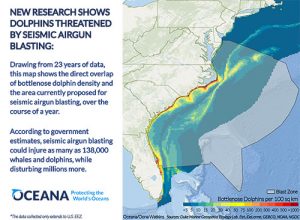
OCEAN CITY — While the multi-state, multi-jurisdictional effort to prohibit potentially dangerous seismic air gun testing off the mid-Atlantic coast continues, a national advocacy group this week released animated maps illustrating the practice’s impact on marine mammals including whales and dolphins.
In mid-March, the federal government reversed course on a controversial plan to lease a vast area totaling three million acres off the mid-Atlantic coast for offshore drilling for oil and natural gas reserves. The reversal came after strong opposition to the proposal from local, state and federal elected officials, environmental advocacy groups and hundreds of coastal communities whose economies rely on clean oceans, healthy natural resources, tourism and commercial and recreational fishing.
However, left on the table was a federal Bureau of Ocean Energy Management (BOEM) proposal to allow private sector companies to utilize potentially harmful seismic air gun testing to determine what oil and gas reserves lay beneath the ocean floor off the mid-Atlantic coast in some areas as close as 20 miles from Ocean City and neighboring Delaware resort communities. While the proposed plan to open the offshore areas to drilling was abandoned, seismic air gun testing for those same reserves remains a real threat.
This week, the national advocacy group Oceana released a series of animated maps showing the extent of the possible impact of seismic air gun testing on marine mammals including dolphins and whales along the mid-Atlantic coast including Delmarva. The maps, based on groundbreaking research from the Duke University Marine Geospatial Ecology Lab, draw from decades of data and show the density of bottlenose dolphins and endangered fin, humpback and sperm whales overlaid with the current seismic air gun permit application area. According to the research and associated maps released this week, the proposed seismic testing lease areas overlap considerably with areas off the mid-Atlantic coast that have dense populations of dolphins and whales for much of the year. According to Oceana, seismic air gun testing in the proposed areas, which extend from Delaware to Florida and include a swath of ocean twice the size of California, could injure as many as 138,000 whales and dolphins while disturbing millions more.
“These maps confirm what we’ve long feared, that dolphins and whales along the east coast are at risk from dangerous seismic air gun blasting for oil and gas,” said Oceana campaign director Claire Douglass. “Hearing that whales and dolphins could be injured is one thing, but seeing the scale of the threat is another.”
Last year, BOEM released its final Programmatic Environmental Impact Statement (PEIS) for seismic air gun blasting in the mid-Atlantic, essentially opining the potential rewards outweigh any possible impacts to marine life. While there are still several hurdles to overcome before any seismic air guns are blasted into the ocean floor off the resort’s coast, the PEIS represents the federal government’s intention to move forward with the practice despite the outcry of opposition from nearly all corners.
In late July, that opposition continued when over 40 legislators from Maryland and Delaware sent a letter to Department of Interior Secretary Sally Jewell calling on the federal government to abandon the idea of seismic air gun testing off the mid-Atlantic coast. The letter, signed locally by Delegates Mary Beth Carozza and Charles Otto, along with 40 other state Delegates and Senators, essentially thanked BOEM for abandoning plans to drill offshore, but urged the federal agency to cease moving forward with seismic air gun testing leases.
With the release of its interactive maps this week showing the density of marine life along the mid-Atlantic coast superimposed with the proposed seismic testing areas, Oceana illustrates the potential impact of the extremely loud practice, which has been compared to in some studies as 100 times louder than a jet engine.
“We already know that the noise from seismic air guns is especially concerning for marine life, including fish, turtles, whales and dolphins, which depend on sound for communication and survival,” said Oceana marine scientist Dr. Ingrid Biedron. “The noise from these blasts is so loud that it can be heard up to 2,500 miles from the source, which is approximately the distance from Washington, D.C. to Las Vegas. These animated maps clearly show that marine life, including dolphins and whales, would be profoundly impacted by the proposed seismic blasting.”
To date, over 110 communities, 1,000 elected officials and 1,100 businesses along with chambers of commerce, and fisheries organizations including the Billfish Foundation and the International Game Fish Association have publicly opposed seismic air gun testing off the mid-Atlantic coast. Closer to home, the towns of Ocean City and Berlin have adopted formal resolutions opposing the practice.

